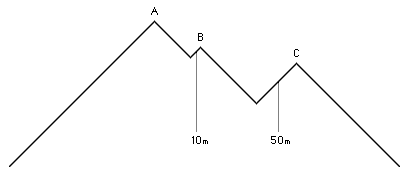Two types of drop
The problem
A peak's drop is defined as:
| Drop is the difference between the height of the peak and the height of the highest col connecting the peak to any higher peak |
The implication is that the drop of Ben Nevis is 1344m, which is the height of Ben Nevis above sea level, because there is no higher peak in mainland Britain and so to get to a higher peak a climber would need to descend to sea level, catch a ferry and climb a peak in continental Europe. The problem is that the drop measure is not very useful when applied to the highest peak on an island or continent, or even to the highest peak in a massif. If Ben Nevis is being climbed from its neighbour Carn Mor Dearg then what we want to know is the ascent needed to climb Ben Nevis from the col with Carn Mor Dearg. This is 286m.
A second drop definition
Let's use the term drop as normal for the 1344m figure and introduce a new term drop2 for the 286m figure. The drop2 of a peak A is then defined as:
| Drop2 is the difference between the height of peak A and the height of the highest col connecting peak A to any other peak B, where peak B may be lower than any other nearby peaks and may be lower than peak A. |
Defining peak B
We need to define 'peak' for the purposes of choosing an object peak B. Why? Suppose we want to find the drop2 of peak A in Figure 1. Peak A has a lower peak B connected to it. Peak B has 10m of drop to peak A, and peak B is itself connected to a lower peak C. Peak C has 50m of drop to peak B.
Figure 1

Now define a peak as a hill with at least n metres of drop. If n is less than 10, then the intermediate peak B counts as a peak, because with 10m of drop to peak A it has enough drop to qualify, so peak B can be used for measuring peak A's drop2. Thus peak A's drop2 is the difference between the height of peak A and the height of the col between peak A and peak B. But if the required drop n is greater than 10m but less than 50m, then peak B is not a peak, but peak C is, and so peak A's drop2 is the difference between the height of peak A and the height of the col between peak B and peak C.
Hence in this situation the lower the drop (n) needed for a hill to be a peak in its own right, the lower the drop2 of peak A might be. So we come down to the old problem of choosing a number n.
The case of the Welsh 3000s
The Welsh 3000s are the fifteen 3000ft (915m) high peaks in Wales. They are spread over three massifs. For the highest peak in each massif, drop2 does not equal drop, as seen in the last column below.
No. |
Peak |
Massif |
Ht |
Drop |
Drop2 |
Drop - Drop2 |
|
|
|
|
|
|
|
The upshot
The upshot is that once we've chosen a figure for the minimum drop of a qualifying peak, n, we can use drop2 to compare the ascents needed to climb all the peaks in a particular massif, the highest peak included. This is what we want to know, as we often climb peaks from other peaks - we don't necessarily climb the highest peaks straight from the valley.
For practical purposes the figure n isn't needed in order to find the height to be climbed. A simple glance at the map tells you drop2.